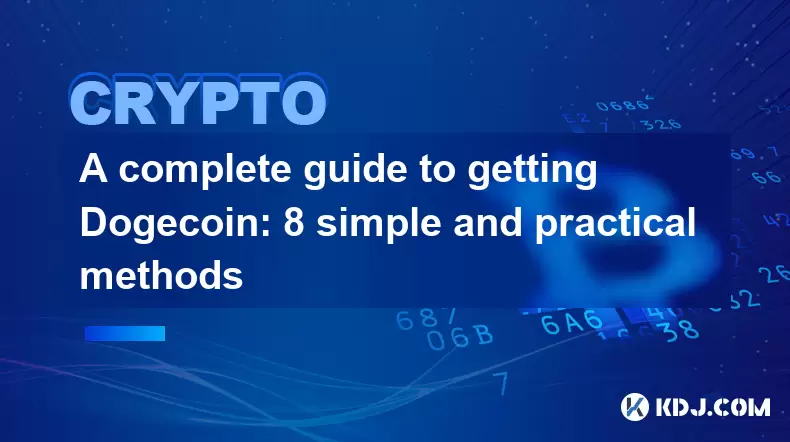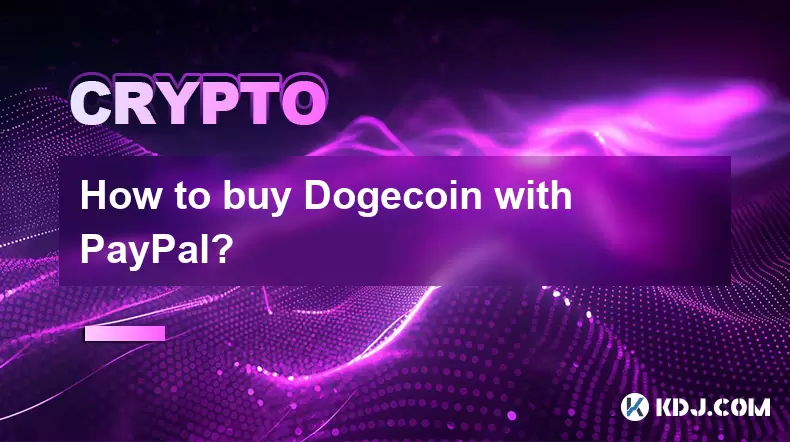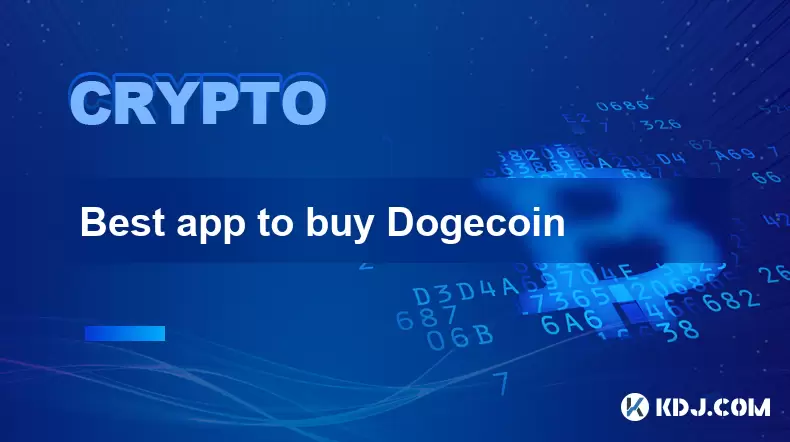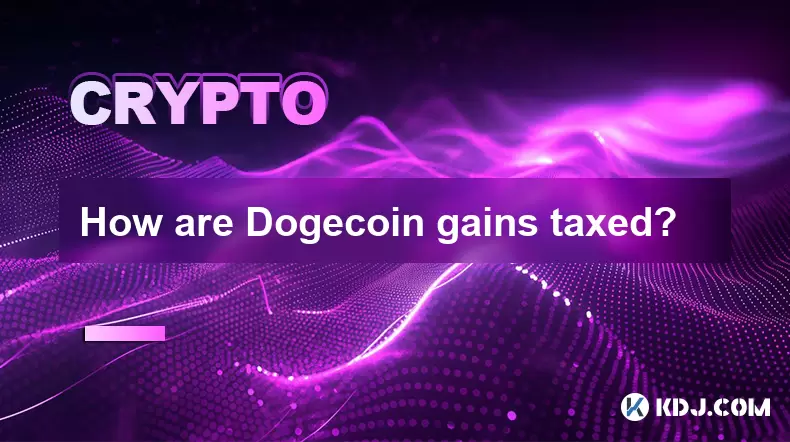-
 bitcoin
bitcoin $120167.907534 USD
1.27% -
 ethereum
ethereum $4468.611945 USD
2.53% -
 xrp
xrp $3.013607 USD
1.80% -
 tether
tether $1.000549 USD
-0.01% -
 bnb
bnb $1092.592149 USD
6.28% -
 solana
solana $231.391244 USD
4.59% -
 usd-coin
usd-coin $0.999699 USD
-0.04% -
 dogecoin
dogecoin $0.259020 USD
4.30% -
 tron
tron $0.342747 USD
0.34% -
 cardano
cardano $0.860977 USD
1.07% -
 hyperliquid
hyperliquid $50.155412 USD
5.34% -
 chainlink
chainlink $22.637678 USD
0.46% -
 ethena-usde
ethena-usde $1.000528 USD
-0.07% -
 avalanche
avalanche $30.613779 USD
-0.07% -
 stellar
stellar $0.403905 USD
0.94%
A complete guide to getting Bitcoincoin: 8 simple and practical methods
Dogecoin can be acquired through exchanges, P2P platforms, mining, receiving payments, faucets, trading, airdrops, and staking or yield farming.
Jun 04, 2025 at 05:43 am

In the dynamic world of cryptocurrencies, Dogecoin has carved out a unique niche for itself. Originally created as a meme-inspired cryptocurrency, Dogecoin has gained significant traction and a dedicated community. If you're interested in getting your hands on some Dogecoin, this guide will walk you through eight simple and practical methods to acquire this popular digital asset. Whether you're a seasoned crypto enthusiast or a newcomer, these methods are designed to be straightforward and accessible.
Buying Dogecoin on a Cryptocurrency Exchange
One of the most common ways to acquire Dogecoin is through a cryptocurrency exchange. Cryptocurrency exchanges are platforms where you can buy, sell, and trade various cryptocurrencies, including Dogecoin. Here's how you can do it:
- Choose a reputable exchange: Look for exchanges that support Dogecoin, such as Binance, Coinbase, or Kraken. Research their fees, security measures, and user reviews to ensure you're choosing a trustworthy platform.
- Sign up and verify your account: Create an account on the chosen exchange and complete the necessary verification process. This usually involves providing personal information and sometimes submitting identification documents.
- Deposit funds: Once your account is set up, deposit funds into your exchange wallet. You can typically do this using a bank transfer, credit/debit card, or another cryptocurrency.
- Place an order: Navigate to the trading section of the exchange, select the Dogecoin trading pair (e.g., DOGE/USD), and place a buy order. You can choose between a market order, which executes immediately at the current market price, or a limit order, which allows you to set a specific price at which you want to buy.
- Withdraw your Dogecoin: After your order is filled, you can withdraw your Dogecoin to a personal wallet for added security.
Using a Peer-to-Peer (P2P) Platform
Another effective method to get Dogecoin is through peer-to-peer (P2P) platforms. These platforms connect buyers and sellers directly, allowing you to purchase Dogecoin from other users. Here's how to use a P2P platform:
- Select a P2P platform: Popular options include LocalBitcoins and Paxful, both of which support Dogecoin. Choose a platform that suits your needs and offers a user-friendly interface.
- Create an account: Sign up for an account on the chosen P2P platform and complete any required verification steps.
- Browse listings: Look through the available listings to find a seller offering Dogecoin at a price you're comfortable with. Pay attention to the seller's reputation and feedback from other users.
- Initiate a trade: Once you've found a suitable seller, initiate a trade by sending the agreed-upon payment method (e.g., bank transfer, PayPal, or cash deposit).
- Release the Dogecoin: After the seller confirms receipt of payment, the Dogecoin will be released to your P2P platform wallet. You can then transfer it to your personal wallet.
Earning Dogecoin Through Mining
For those interested in a more hands-on approach, mining Dogecoin can be a viable option. Mining involves using specialized hardware to solve complex mathematical problems, which in turn validates transactions on the Dogecoin blockchain and earns you new coins. Here's how to get started with mining:
- Understand the requirements: Mining Dogecoin requires a computer with a powerful graphics processing unit (GPU) or an application-specific integrated circuit (ASIC) designed for cryptocurrency mining.
- Choose mining software: Select a mining software that supports Dogecoin, such as CGMiner or EasyMiner. These programs will help you connect to the Dogecoin network and start mining.
- Join a mining pool: To increase your chances of earning Dogecoin, consider joining a mining pool. Mining pools combine the computing power of multiple miners, increasing the likelihood of solving blocks and earning rewards. Popular Dogecoin mining pools include AikaPool and ProHashing.
- Configure your miner: Set up your mining software to connect to the chosen mining pool and start mining. Follow the pool's instructions for setting up your wallet address to receive your earned Dogecoin.
- Monitor and maintain: Regularly check your mining setup to ensure everything is running smoothly. Keep your hardware cool and up to date to maximize efficiency and earnings.
Receiving Dogecoin as Payment
If you're involved in freelancing, running a business, or simply offering services, you can receive Dogecoin as payment. This method allows you to earn Dogecoin directly from your work or products. Here's how to set it up:
- Create a Dogecoin wallet: First, you'll need a wallet to receive Dogecoin. Popular options include the official Dogecoin Core wallet, mobile wallets like Trust Wallet, or hardware wallets like Ledger.
- Generate a receiving address: Once your wallet is set up, generate a receiving address. This is the unique string of characters where people will send Dogecoin to pay you.
- Inform your clients or customers: Let your clients or customers know that you accept Dogecoin as payment. Include your receiving address in invoices, on your website, or in any communication about payment.
- Track your payments: Keep an eye on your wallet to confirm when payments are received. Most wallets allow you to label transactions for easy tracking.
- Convert if needed: If you need to convert your Dogecoin to another currency, you can do so through a cryptocurrency exchange or a P2P platform.
Participating in Dogecoin Faucets
Dogecoin faucets are websites that distribute small amounts of Dogecoin for free, usually in exchange for completing simple tasks like watching ads or solving captchas. While the amounts are small, faucets can be a fun and easy way to accumulate Dogecoin. Here's how to use them:
- Find a reputable faucet: Search for Dogecoin faucets online and choose one that has a good reputation and regular payouts. Some popular options include FreeDogecoin and Moon Dogecoin.
- Create an account: Sign up for an account on the faucet website. Some faucets may require you to provide an email address or other basic information.
- Complete tasks: Follow the instructions on the faucet to complete tasks and earn Dogecoin. These tasks can include watching ads, solving captchas, or participating in surveys.
- Withdraw your earnings: Once you've accumulated enough Dogecoin, you can withdraw it to your personal wallet. Each faucet will have a minimum withdrawal threshold, so be sure to check this before starting.
- Stay safe: Be cautious of scams and only use reputable faucets. Never provide sensitive personal information or pay money to use a faucet.
Trading Other Cryptocurrencies for Dogecoin
If you already own other cryptocurrencies, you can trade them for Dogecoin on various exchanges. This method allows you to diversify your crypto portfolio without needing to deposit fiat currency. Here's how to do it:
- Choose an exchange: Select an exchange that supports trading between your existing cryptocurrency and Dogecoin. Many major exchanges like Binance and Coinbase offer this option.
- Transfer your crypto: Send your existing cryptocurrency to your exchange wallet. Make sure to use the correct deposit address to avoid losing your funds.
- Navigate to the trading pair: Find the trading pair that matches your cryptocurrency with Dogecoin (e.g., BTC/DOGE or ETH/DOGE).
- Place a trade: Decide on the amount of cryptocurrency you want to trade and place a buy order for Dogecoin. You can choose between a market order or a limit order, depending on your trading strategy.
- Withdraw your Dogecoin: Once the trade is complete, you can withdraw your newly acquired Dogecoin to your personal wallet.
Participating in Dogecoin Airdrops
Dogecoin airdrops are events where a project distributes free Dogecoin to participants. These events are often used to promote new projects or reward existing community members. Here's how to participate in a Dogecoin airdrop:
- Stay informed: Keep an eye on Dogecoin-related news and social media channels to learn about upcoming airdrops. Websites like Airdrop Alert and CoinMarketCap can also provide information on upcoming events.
- Follow the instructions: Each airdrop will have specific instructions on how to participate. This may involve signing up for a newsletter, joining a Telegram group, or completing a task.
- Provide your wallet address: You'll need to provide your Dogecoin wallet address to receive the airdropped coins. Make sure to double-check the address to avoid errors.
- Complete any required tasks: Some airdrops may require you to complete additional tasks, such as sharing the event on social media or referring friends.
- Claim your Dogecoin: Once the airdrop is complete, follow the instructions to claim your Dogecoin. The coins will be sent to the wallet address you provided.
Earning Dogecoin Through Staking or Yield Farming
For those looking to earn passive income, staking or yield farming can be an effective way to accumulate Dogecoin. These methods involve locking up your Dogecoin in a platform or protocol to support its operations and earn rewards. Here's how to get started:
- Choose a platform: Look for platforms that offer Dogecoin staking or yield farming opportunities. Some popular options include Crypto.com and Binance.
- Transfer your Dogecoin: Send your Dogecoin to the chosen platform's wallet. Make sure to use the correct deposit address to avoid losing your funds.
- Select a staking or farming option: Navigate to the staking or yield farming section of the platform and choose an option that suits your risk tolerance and desired returns.
- Lock up your Dogecoin: Follow the platform's instructions to lock up your Dogecoin in the chosen staking or farming pool. This may involve selecting a duration and agreeing to the terms.
- Earn rewards: As you participate in staking or yield farming, you'll earn rewards in the form of additional Dogecoin or other tokens. These rewards can be claimed and withdrawn to your personal wallet.
Frequently Asked Questions
Q: Is it safe to store Dogecoin on an exchange?A: While reputable exchanges have security measures in place, it's generally safer to store your Dogecoin in a personal wallet, especially if you're holding large amounts. Hardware wallets offer the highest level of security for long-term storage.
Q: How long does it take to mine Dogecoin?A: The time it takes to mine Dogecoin depends on various factors, including the power of your mining hardware and whether you're mining solo or in a pool. Joining a mining pool can significantly reduce the time it takes to earn rewards.
Q: Can I use Dogecoin for everyday purchases?A: Yes, some merchants and online platforms accept Dogecoin as payment. However, its adoption for everyday purchases is still limited compared to more established cryptocurrencies like Bitcoin and Ethereum.
Q: What is the minimum amount of Dogecoin I can withdraw from a faucet?A: The minimum withdrawal amount varies from one faucet to another. It's typically a small amount, often between 10,000 to 50,000 Dogecoin, depending on the faucet's policies.
Disclaimer:info@kdj.com
The information provided is not trading advice. kdj.com does not assume any responsibility for any investments made based on the information provided in this article. Cryptocurrencies are highly volatile and it is highly recommended that you invest with caution after thorough research!
If you believe that the content used on this website infringes your copyright, please contact us immediately (info@kdj.com) and we will delete it promptly.
- BlockDAG, DOGE, HYPE Sponsorship: Crypto Trends Shaping 2025
- 2025-10-01 00:25:13
- Deutsche Börse and Circle: A StableCoin Adoption Powerhouse in Europe
- 2025-10-01 00:25:13
- BlockDAG's Presale Buzz: Is It the Crypto to Watch in October 2025?
- 2025-10-01 00:30:13
- Bitcoin, Crypto, and IQ: When Genius Meets Digital Gold?
- 2025-10-01 00:30:13
- Stablecoins, American Innovation, and Wallet Tokens: The Next Frontier
- 2025-10-01 00:35:12
- NBU, Coins, and Crypto in Ukraine: A New Yorker's Take
- 2025-10-01 00:45:14
Related knowledge

Bitcoincoin burning mechanism
Jul 20,2025 at 09:21pm
What is the Dogecoin burning mechanism?The Dogecoin burning mechanism refers to the process of permanently removing DOGE tokens from circulation by se...

How to earn free Bitcoincoin?
Jul 19,2025 at 10:08pm
What is Dogecoin and Why Earn It?Dogecoin (DOGE) started as a meme-based cryptocurrency in 2013 but has grown into a widely recognized digital asset. ...

Is Coinbase a good wallet for Bitcoincoin?
Jul 19,2025 at 04:42pm
Understanding Coinbase as a Wallet Option for DogecoinWhen considering where to store Dogecoin, Coinbase is often mentioned as a potential option due ...

How to buy Bitcoincoin with PayPal?
Jul 23,2025 at 06:57am
Understanding the Basics of Buying DogecoinBefore diving into the process of buying Dogecoin with PayPal, it’s essential to understand what Dogecoin i...

Best app to buy Dogecoin
Jul 23,2025 at 03:08pm
What Is a Cryptocurrency Exchange and How Does It Work?A cryptocurrency exchange is a digital marketplace where users can buy, sell, or trade cryptocu...

How are Dogecoin gains taxed?
Jul 25,2025 at 07:01am
Understanding the Taxation of Dogecoin GainsWhen it comes to Dogecoin (DOGE), many investors are drawn to its meme-inspired branding and volatile pric...

Bitcoincoin burning mechanism
Jul 20,2025 at 09:21pm
What is the Dogecoin burning mechanism?The Dogecoin burning mechanism refers to the process of permanently removing DOGE tokens from circulation by se...

How to earn free Bitcoincoin?
Jul 19,2025 at 10:08pm
What is Dogecoin and Why Earn It?Dogecoin (DOGE) started as a meme-based cryptocurrency in 2013 but has grown into a widely recognized digital asset. ...

Is Coinbase a good wallet for Bitcoincoin?
Jul 19,2025 at 04:42pm
Understanding Coinbase as a Wallet Option for DogecoinWhen considering where to store Dogecoin, Coinbase is often mentioned as a potential option due ...

How to buy Bitcoincoin with PayPal?
Jul 23,2025 at 06:57am
Understanding the Basics of Buying DogecoinBefore diving into the process of buying Dogecoin with PayPal, it’s essential to understand what Dogecoin i...

Best app to buy Dogecoin
Jul 23,2025 at 03:08pm
What Is a Cryptocurrency Exchange and How Does It Work?A cryptocurrency exchange is a digital marketplace where users can buy, sell, or trade cryptocu...

How are Dogecoin gains taxed?
Jul 25,2025 at 07:01am
Understanding the Taxation of Dogecoin GainsWhen it comes to Dogecoin (DOGE), many investors are drawn to its meme-inspired branding and volatile pric...
See all articles










































































